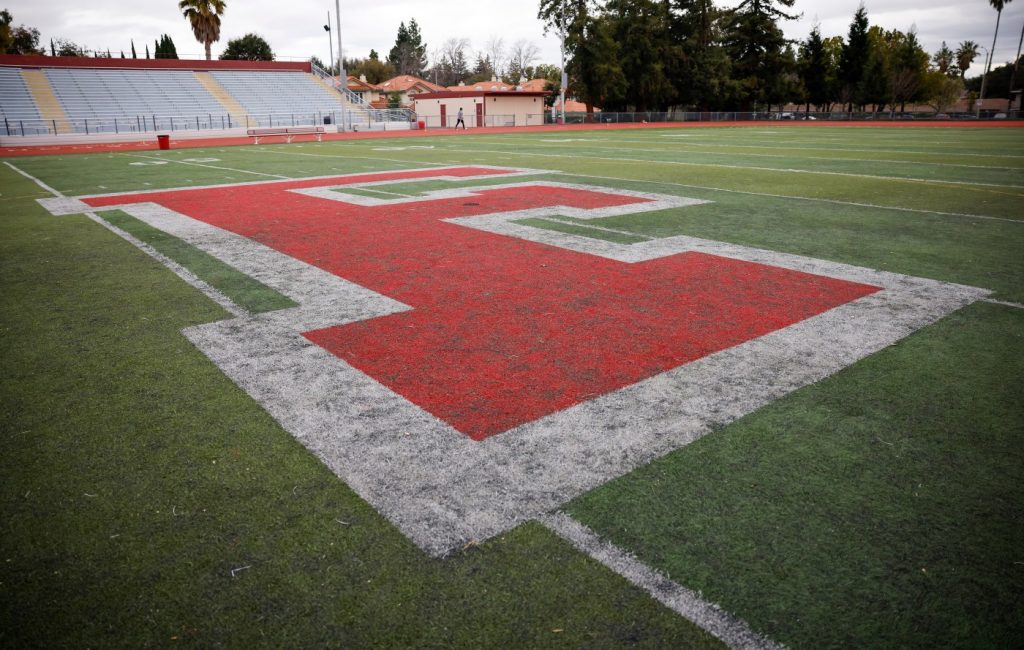A push to replace a dozen synthetic athletic fields with real grass at five area high schools is gaining support from those concerned about the environmental hazards associated with artificial turf that can leach “forever chemicals” and pose a health risk for students.
The Fremont Union High School District board of trustees is expected to take up the issue Tuesday night amid a plan to update the turf at Fremont, Homestead, Lynbrook, Monte Vista and Cupertino high schools, part of the district’s goal to repair and replace old turf fields over the next few years.
The district used bond funding to replace 12 of its 15 grass fields between 2009 and 2013 in an effort to conserve water and improve athletic facilities. The remaining three fields were converted in 2018. The turf has a life expectancy of eight to 10 years, leading local health and environmental enthusiasts to recommend the change now.
“I think considering all the negative impacts, there really is no good benefits for keeping artificial turf,” said Lynbrook High School junior Daphne Zhu. “The fact that it’s plastic and not degradable or recyclable, it’s not better for athletes’ health and for the environment.”
Cupertino High School junior Clarabelle Wang supports grass as a matter of personal preference. Wang, who runs track and field, said warming up on an artificial field can be uncomfortable, especially during hot days when the turf absorbs heat. The small bits of turf that gets into her shoes doesn’t make exercising an enjoyable experience either.
“I feel like it has been more of a burden to use artificial turf, at least my school,” Wang said. “There are lot of little rock and pieces everywhere and it would get into everyone’s shoes and stuff like that.”
Synthetic turf has come under increasing scrutiny as it can can contain hazardous microplastics and chemicals like PFAS, known as “forever chemicals.” The latter can leach into food chains, contaminate water supplies and have negative developmental affects on children and others.
In August 2023, the Santa Clara County Medical Association penned a letter about the health concerns of the artificial turf to the Los Gatos-Saratoga Unified High School District, which was receiving community push to replace their turf fields with grass.
The Loma Prieta Chapter of the Sierra Club also wrote to the Santa Clara County Board of Supervisors in November about how the plastic turf is difficult to break down and properly dispose. The turf fades and cracks overtime, the letter states, which can cause small bits of plastic to enter waterways.
The school district conducted a study session in September for staff to compare the two options. Lower costs and maintenance associated with synthetic fields provide an incentive for the district to adopt them, according to a session presentation. The cost for replacing the 12 fields with turf is estimated to be $23 million, while the cost for changing all 15 fields to natural turf would cost approximately $35 to $45 million. The district also estimates that synthetic turf makes the fields useable for an estimate 5,040 hours per year versus 2,550 for natural grass.
These reasons don’t persuade Linda Hutchins-Knowles, co-founder of Mothers Out Front Silicon Valley, to support turf. Established in 2016, the local chapter of the nationwide environmental conservation organization is helping parents and students advocate for grass fields. They recently drafted and sent a letter to the school trustees, which was supported and signed by several other local groups and 76 community members, urging them to reject any future artificial turf plans.
Hutchins-Knowles said natural grass is cheaper over its life cycle than artificial turf. Even if district studies say otherwise, she believes trustees should make children’s safety a priority.
“The people that we are entrusting with decisions that effect our kids’ health and safety need to center those kids needs first and foremost,” she said. “It’s not OK to say we’re willing to sacrifice and risk their health and safety to save money or to make things easier on the district’s staff.”


